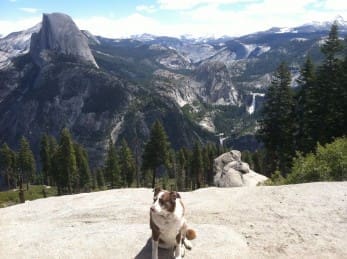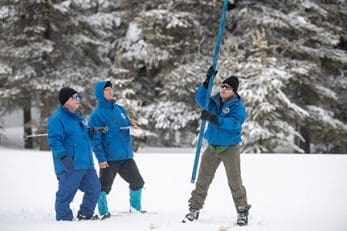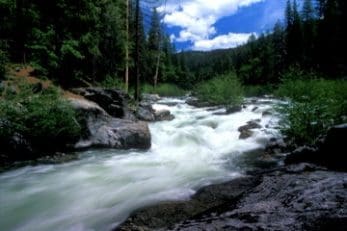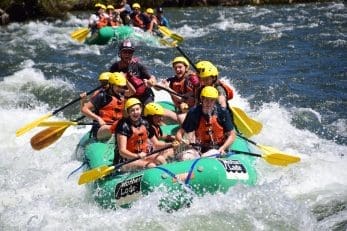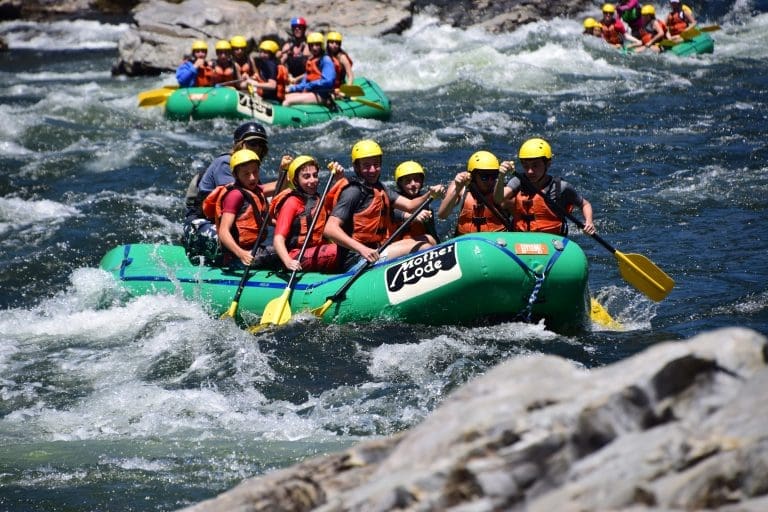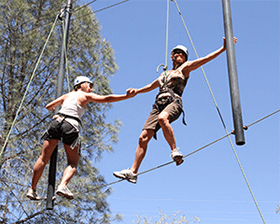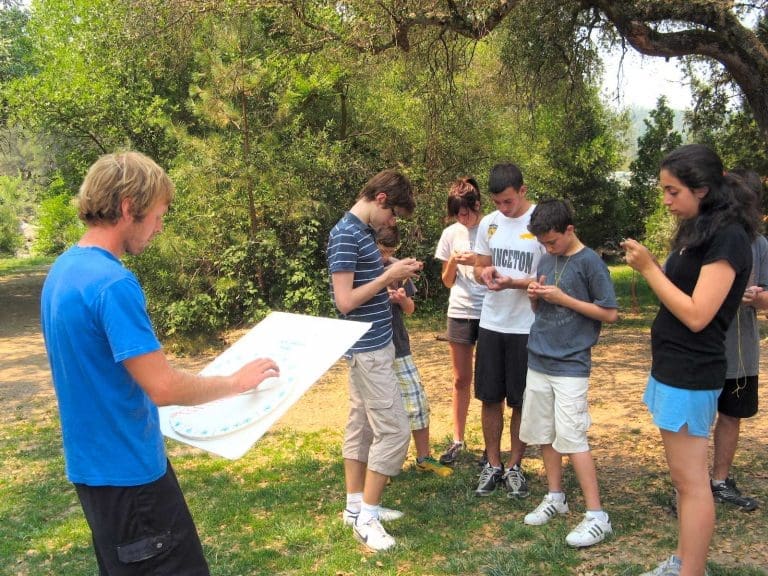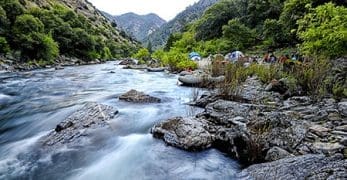 Drift boating past River’s Bend, the river turns sharply westward toward the evening sun. A low-pitched growling becomes progressively louder as the river gradually transforms itself from a smooth, glass-like surface into a series of riffles, then into churning waves of whitewater. Submerged rocks reveal themselves by creating upstream pointing Vs of current, and just as avoiding these becomes urgent, the setting sun’s rays blind you.
Drift boating past River’s Bend, the river turns sharply westward toward the evening sun. A low-pitched growling becomes progressively louder as the river gradually transforms itself from a smooth, glass-like surface into a series of riffles, then into churning waves of whitewater. Submerged rocks reveal themselves by creating upstream pointing Vs of current, and just as avoiding these becomes urgent, the setting sun’s rays blind you.
 You blink hard, narrow your eyes to slits, and search for the through line, the downstream pointing V of current that reveals the deepest and safest channel. As the gradient in the rapid steepens, the current accelerates and draws the boat toward danger. This is nothing personal, it is simply the river following gravity toward its origin, the ocean. Born there in Summer as evaporating mist, it rose to condense as clouds, then fell as rain and snow, and finally came to rest in the deep snowbanks of the Sierras. During the Winter, the river was biding its time, waiting until Spring when it completes its cycle as ice-cold, crystal-clear snowmelt, finding its way into streams, swelling to form the river. It then crests dams, and falling over waterfalls, forms meanders that travel through valleys to arrive at the crooked place in the river known as Highway Rapid, the home of the Mother Lode River Center.
You blink hard, narrow your eyes to slits, and search for the through line, the downstream pointing V of current that reveals the deepest and safest channel. As the gradient in the rapid steepens, the current accelerates and draws the boat toward danger. This is nothing personal, it is simply the river following gravity toward its origin, the ocean. Born there in Summer as evaporating mist, it rose to condense as clouds, then fell as rain and snow, and finally came to rest in the deep snowbanks of the Sierras. During the Winter, the river was biding its time, waiting until Spring when it completes its cycle as ice-cold, crystal-clear snowmelt, finding its way into streams, swelling to form the river. It then crests dams, and falling over waterfalls, forms meanders that travel through valleys to arrive at the crooked place in the river known as Highway Rapid, the home of the Mother Lode River Center.
This ‘Highway’ is the Old Coloma Road, or State Highway 49, in the historic Coloma/Lotus Valley. This is not just any road. Once a dirt, two rut wagon track, this is the road that carried Wells Fargo stagecoaches as they connected the site of gold discovery at Sutter’s Mill in Coloma, to Grass Valley and Nevada City to the North, and to Sonora and the Yosemite Valley to the South. It is the road that joined the Golden Chain of settlements referred to as the Mother Lode, and hence the River Center’s name.


We are now midway down the rapid, and all attention is focused on the ledge that forms a small waterfall across two thirds of the river. This is a place not to be trifled with, and several strong oar strokes are required to position the boat with bow downstream to run the drop. I remember this place for many reasons. The first that comes to mind is a morning shrouded in mist. My daughter, Emily, is fishing from her favorite eddy just below this drop on river right. She is tiny and is dwarfed by her fishing pole, and as she reels in what may be a large fish tugging at the line, the torpedo shape of a trout appears. There is a second larger shape immediately behind it that is too large to be a fish. At the last minute the second shape darts away, it is a River Otter! Like Emily, it has pursued its catch until the bitter end, only to disappear as quickly as it came. The amazement we both felt in that moment over forty years ago remains vivid even now. In fact, just a few days ago my 13-month-old grandson, Will, while playing near that same eddy, spotted two otters working their way up against the current searching for food. To complete this circle, all that remains is for little Will to be here in my place, pulling hard on these oars.


And I need to pull hard. The boat has drifted out of position, and daydreaming is about to bring about serious trouble. I arch my back and thrust with my legs against the foot brace to gain additional leverage. The drift boat with its shallow draft and flat bottom responds crispy and surfs rapidly out of harm’s way into a hidden eddy. This is Cassidy Bell’s Eddy, and I take a deep breath and rest my elbows on the oars as the boat settles into its slack water, and my mind wanders again.
I imagine it was on an evening similar to this one that Cassidy’s Eddy earned its name. The story unfolded slowly decades ago. Cass, as Cassidy Bell was known in those days, was a young river guide new to Mother Lode who was enjoying a similar evening run in his kayak. As he pulled the boat out of the water onto the sand of this small eddy, he looked for a better place to view the sunset. A high promontory of granite caught his eye. He scrambled up to it, working his way through an intense thicket of blackberries in the process. As he swept aside the thorny vines he noticed something remarkable- several deep holes in the granite which could only be one thing- bedrock mortars.
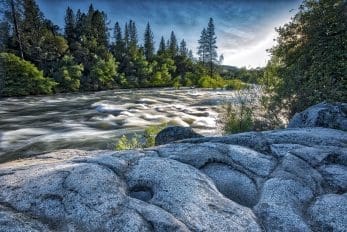
These are depressions created by the Native Americans with Chawsee, or grinding rocks, used to pound acorns gathered from the huge oaks nearby into meal. This discovery was very exciting, yet he did not share it with anyone. Identifying strongly with Native American values himself, Cass was concerned others would not treat this place with the same reverence he did. He kept his discovery a secret– for the entire river season! He brought a large wooden plank and placed it next to the stones, so he could sleep next to them, and to act as their guardian as he absorbed their mystic power. No one knew where Cass went at night. Only when the season ended did Cass share the existence of this place with me.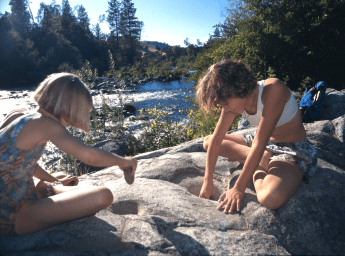

As we explored the granite outcropping together, we were amazed to find other bedrock mortars, over thirty in total. One was over 8 inches in diameter and over 16 inches deep, suggesting it was at least a thousand years old. We realized that this place was an ancient Nisenan village. This mass of granite not only provided Nisenan women a panoramic view of the river as they pounded their acorns, we imagined them watching their men fish for salmon in the river below. Now, as I sit eddied out in Cassidy’s Bell’s Eddy above the stones, I remember Cass and appreciate his special way in the world. It is a way of respect.


To the Mother Lode Guides who today call it home, the River Center and Highway Rapid continue to be such a revered and respected place. Sitting at the river’s edge on a busy weekend, there is certainly a show worthy of an action movie. Yet there is a deeper meaning here that our river family cannot easily describe. Although we choose to share our river home with others, we know that like the Earth itself, this place is alive and sacred. It deserves the reverence that all nature deserves on this, the Blue Planet, the only place we are certain there is life in our vast and ever-expanding Universe.
I have tarried in Cass’s Eddy long enough. It is time to descend Highway Rapid and experience a moment of truth. My goal is not to be part of the drama, but on the contrary, to provide a display of skill that creates a moment of beauty. This is not particularly easy as it turns out. One reason is that the drift boat I am rowing is a unique and especially fragile variety of craft. Graceful, bright maroon, Mother Lode’s version of a traditional drift boat design has a jaunty upturned bow, which carves its way amongst the jagged rocks of the rapid, dropping over the small waterfall in mid-river, and then glides toward the eddy that lies at the rapid’s base. This is home- that is, the Mother Lode Eddy, which is not an easy one to catch.
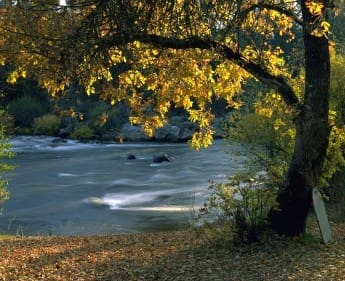
It is formed by a large, partially submerged rock that often upsets rafts, kayaks and other craft, embarrassing the best of guides. To the Mother Lode drift boat, however, this rock is not merely a challenge, but a serious threat. A drift boat has no floatation tubes, no self-bailing floor or pliable rubber sides like a raft. Rather it is made of unforgiving fiberglass, and should it broadside the rock in the eddy, it will likely sink and be destroyed. So now comes the crux, the moment of truth in which the wager against nature is won or lost. How does it end? That is to be determined, and if you are interested in finding out how your own story might unfold, feel free to inquire after a ride. Perhaps drifting down Highway Rapid could be in your future!



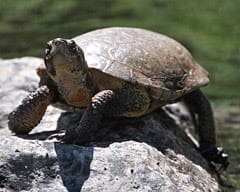
***Highway is the last and largest rapid on the four-mile stretch of the South Fork of the American River that begins in Coloma and ends at Mother Lode Camp. It is a Class II run with one Class III rapid, that is, Highway. Long ago the Mother Lode guides named this run The Bio in honor of another river, the Rio Bio Bio, located in Chile. That majestic river run was destroyed by a dam. It is a fate that has thus far been prevented on the South Fork, and the Mother Lode guides have played an important and inspired role in saving the South Fork and 14 other California rivers from destruction. Whether they share it with you in our drift boat, a self-bailing whitewater raft, a pack raft, or some other craft, our wager is that the grace and beauty of The Bio, and the other runs on the South Fork, the Chili Bar and the Gorge, will convince you that keeping our rivers flowing and alive is worth the struggle.***
